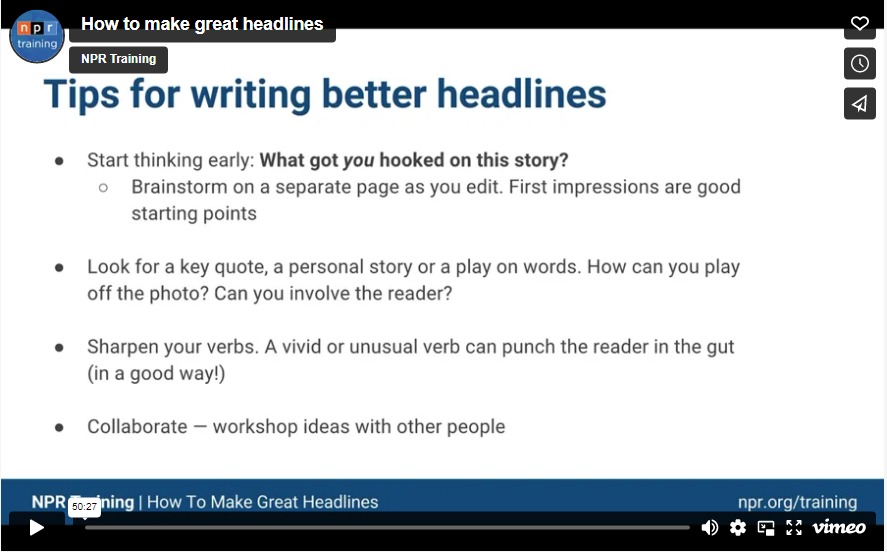
How to write great headlines
that keep readers engaged
COLIN DWYER AND STEPHANIE FEDERICO • OCTOBER 25, 2015

How can you make great headlines?
More than anything, you need an interesting story. Even the greatest headline writer in the world will fail with a boring or confusing story. That’s because the best headlines aren’t necessarily the ones that make people click — they’re the ones that promise great stories and then fulfill that promise.
And here’s the trick: The process of writing headlines can make your story ideas better. Give this post a read for techniques on how to brainstorm headline ideas (for example, write many different headline ideas and write them at the beginning of the workflow).
In this post, we focus on the characteristics all great headlines share. We compiled five tips below. The next time you’re brainstorming ideas, give this list a scan. (Here’s a one-page PDF version if you want to save and print this list.)
Headlines should be specific
Pretend an elevator door is shutting and you want to tell someone on the other side about a story. You’ll need to get the most interesting point across fast, which means you can’t be vague about it.
Same goes for your headline. When people come across it, they’re going to make a snap decision: Do I care about this? Be specific — include enough detail so they can connect to the story and make a decision.
You might think it’s better to be mysterious with details to make people click. To make them feel obligated to view the story. Like if I had titled this piece, The Five Tricks That Will Make You Think Differently About Writing.
But the purpose of a good headline isn’t only to get people to click (or at least it shouldn’t be for public media). We want to create a positive experience for people — from spotting the headline to clicking to reading/watching/listening to sharing to returning. We don’t want people to feel tricked or disappointed, right?
And again — if it’s a good story, the headline will reflect it.

Headlines should be easy to understand
When someone sees your headline, there’s a pretty good chance they’re looking at it on their mobile device while skimming Facebook. The screen is small and the experience is fast.
You have a second or two to make your point. So when you’re writing your headline, make sure people can easily understand it.
Keep it simple — avoid names and acronyms that aren’t universally recognized. For example, if I had titled this piece, “Eric Athas of the NPR ETT on headlines,” people would be unfamiliar with my name and confused by “ETT.”
Also avoid words that almost only appear in headlines (“5 headline ideas you can mull to bolster your stories”).
You should also consider how people will be able to understand your headline out of context, without an image next to it (similarly, you should be thoughtful about how your photo matches with your headline when they are together — the wrong pairing can be trouble). Remember, the headline is possibly the only part of your story that travels to all corners of the internet. It should make sense to people wherever it lands — Facebook, Twitter, Google, RSS.

Headlines should lead to a reaction
You’re writing headlines for people. People looking for something interesting to read or watch or listen or share. How will your target audience react when they see your headline? Will they be curious? Surprised? Sad? Angry? Happy? Will they click on it? Will they share it?
Try to imagine this scenario. Test it out. Show a friend your headline and ask for a gut-reaction.

Headlines should not be overly clever
Headlines, just like your stories, should be infused with voice and style and creativity. This is the case especially for public media.
With that in mind, be cautious of the overly clever headline.
A headline with a pun or a cultural reference is fun to write, but is it needed? Will people get it? Or will people spend too much time trying to “get” your joke?
Again — creative and unique and full of life, but not too clever. Don’t use sight of the promise.

Headlines should capture the spirit of the story
In addition to the four characteristics outlined above, the headline should tap into the spirit of the story.
Is it a happy story? A serious one? Is it an essay? An investigative piece?
If the story is written with voice, that voice should maybe come through in the headline. On the other hand, if the story is newsy and straight-forward, maybe it doesn’t need a lot of voice injected into it.
As you’re brainstorming ideas, ask yourself if the story’s essence matches the headline.

Now that you’ve read through the checklist, keep in mind: These are not rules. They’re ideas. And they all work together to help construct a headline that delivers an enjoyable experience for people.
******************************************
Related Articles
How to Write Headlines That Work
How to Write a Headline: 5 Tips for Writing a Good Headlines
4 Simple but Powerful Tactics for Writing Compelling Ad Copy
12 Ad Copy Strategies That’ll Double Your CTR and Increase Your ROI
Other Important Topics
Features:


